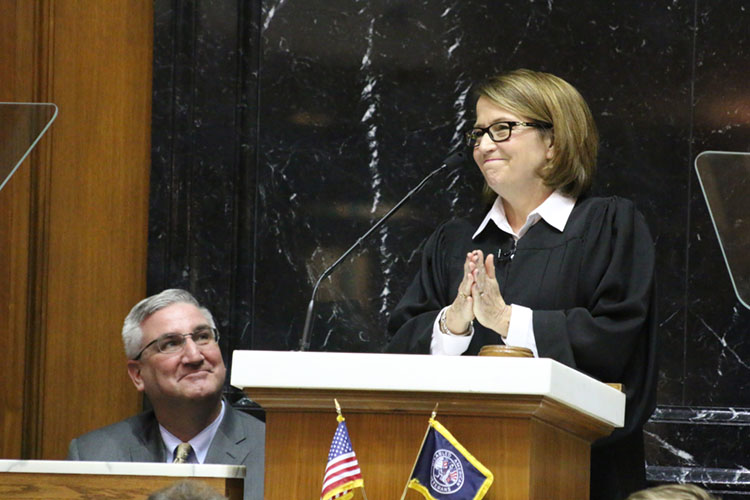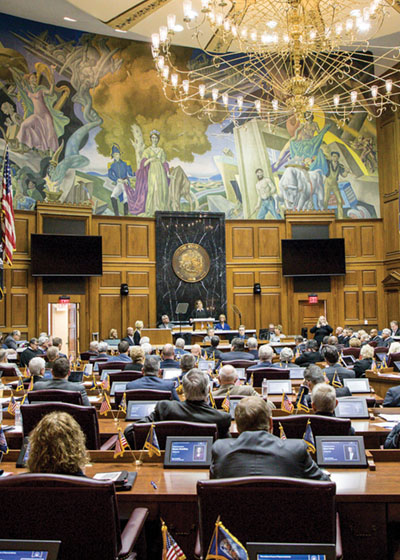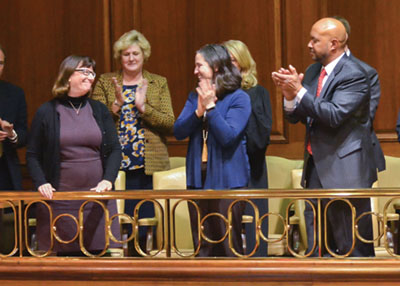
A Hope-Filled Future
On January 10, 2018, Chief Justice of Indiana Loretta Rush delivered her fourth address on the State of the Judiciary to a joint session of the Indiana General Assembly.
Highlights of the speech follow. We also invite you to read the entire text, watch the video, and view photographs at: courts.in.gov/supreme/2570.htm
The Supreme Court Justices and Court of Appeals Judges were greeted by escorts from the House and Senate, including Representatives Jim Baird, Sheila Klinker, Robin Shackleford, Tom Washburne and Senators Aaron Freeman, Tim Lanane, Victoria Spartz, and Greg Taylor. Guests, media, elected officials, and over 60 trial court judges were present. Lt. Gov. Suzanne Crouch called the session to order.
Before the address, those present saw a montage of photos from the happiest day in court: Adoption Day. The Supreme Court allowed the use of cameras in court for those proceedings to capture the hope-filled faces of some of the 220 children in 33 Indiana courthouses who joined their forever families in one of the most adoption-friendly states in the country.
Chief Justice Rush reported that the judicial branch is renewed, respected, and resolved – in a word, strong.
In 2017, there were 1,316,714 cases filed in our trial courts ranging from business litigation to foreclosures, from family violence to property rights, from human trafficking to elder abuse and, of course, the drug crisis.
The Drug Crisis
In preparing her remarks, the Chief Justice asked the Governor and legislative leaders for their input. The common question: how is the judiciary addressing the opioid crisis?
Addiction has swept into every community and is flooding every court—not just in Indiana, but across our country. Rush, who was recently appointed co-chair of the National Judicial Opioid Task Force, reported that this crisis requires using well-reasoned, evidence-based judicial interventions to get people to treatment, give consequences, cut the supply, support families, and save lives.
The Indiana judiciary is responding to the opioid crisis by:
- Convening teams from each county to participate in extensive training on treatment for substance use disorder;
- Developing a judicial toolbox for effective and evidence-based court-ordered drug treatment;
- Extending the reach of problem-solving courts, which will number over 100 by the end of this year;
- Advancing drug courts in child welfare cases that involve the entire family in the parents’ treatment;
- Expanding our corps of CASA volunteers to support the children of parents swept up in the horrors of addiction;
- Supporting community corrections, pretrial, and jail-based programs so treatment begins as early as possible;
- Leveraging court technology to slow the supply of drugs from hitting Indiana streets; and
- Supporting efforts to expand treatment and prevention programs in our communities.

Administrative Restructuring
The Court completed an extensive restructuring by consolidating Court agencies into a single Office of Judicial Administration under the leadership of Chief Administrative Officer Mary Willis.
Chief Financial Officer Aaron Hood serves as a single point of contact for all fiscal matters. The Indianapolis Business Journal recently honored him as a top government CFO.
The Office of Personnel and Operations, led by Brenda Rodeheffer, worked to move administrative offices closer to the State House at a lower rent.
The Indiana Office of Court Services combines the former Indiana Judicial Center and Division of State Court Administration, streamlining interactions with judges and maintaining high-caliber training and programming.
The Court combined Continuing Legal Education and the Board of Law Examiners into the highly effective Office of Admissions and Continuing Education, celebrating 30 years of legal education for Indiana’s 20,000 practicing lawyers and judges.
Cass County Judge Rick Maughmer led an in-depth study of judicial resources, after which the Court adopted a rule to allow judges to operate across county lines to provide assistance where needed. Judges are also crossing county lines to develop regional drug or veterans courts as they have in Warren and Fountain counties.
Modernizing Indiana’s Judicial Branch
Rush touted 24/7 access to the courts through electronic filing and an integrated case management system. Each week 100,000 documents are electronically filed, and 71% of all new cases are in one case management system, with the goal of the entire state to be electronically filing within the next year.
Court data sharing efforts include:
- Tracking 7,000 new adult guardianships;
- Reporting 11,000 mental-health adjudications to the FBI;
- Submitting 900,000 protection orders to the registry;
- Giving policymakers an analysis of nearly 300,000 felony cases to help guide criminal code reform; and
- Providing the Department of Education with 40,000 cases so they are aware of convictions that would disqualify a person from teaching children.
Pharmacies also use Indiana criminal data to prevent the sale of medicines used to make methamphetamine. The 42,700 people named in the system will not be able to buy the meth precursors to cook and sell more drugs.

A Wiser Judicial Branch
Indiana’s judicial branch is staying ahead of the challenges faced through commitment to rigorous education and training programs for judges and their staffs.
Training initiatives have been led by Jane Seigel, who is retiring after 20 years of service. In this past year alone, training sessions were presented on criminal justice reform, increased needs of our elderly, technology, civil justice reform, commercial courts, substance abuse treatment, racial bias, juvenile justice, child welfare, domestic violence, bail reform, problem-solving courts, and more.
Well-trained Court Appointed Special Advocates, or CASAs, are more crucial than ever. In 2017, the CASA program served the second-highest number of children in the country—26,000 children.
Problem-solving courts increased by 10% in the past year with 87 currently and 15 more being developed. These courts require pioneering judges, supportive communities, and tremendous training resources that are crucial for addressing the drug crisis.
In Grant County, Judge Dana Kenworthy established the specialized Family Recovery Court to include not just the addicted, but also their children—the hidden victims of this drug crisis.
Meeting the Justices
In fiscal year 2017, the Court reviewed 885 cases, issued 73 majority opinions, and held 59 oral arguments. Traveling arguments took place at Gary Roosevelt High School and the University of Southern Indiana in Evansville. The Indiana Court of Appeals recently held their 500th traveling argument—a milestone worth celebrating.
“We’re relatively new—especially compared to the 11-year span when there was no change in Court membership. You might call that the ‘Fab Five’ era of Justices Shepard, Dickson, Sullivan, Boehm, and Rucker. But your new Court brings a combined 150 years of legal and judicial experience. Our greatest strength is our collective decision-making ability,” Rush stated during her address prior to introducing each of her colleagues on the bench.
Justice Steven David
Justice Steven David, native Hoosier and a highly distinguished 28-year Army veteran with tours of duty in Iraq, Guantanamo Bay, Panama, and Germany. Colonel David was awarded the Defense Superior Service Award. He leads Indiana’s expansion of veteran’s courts.
David’s 22-year judicial career followed nine years as corporate counsel and as a private practice attorney. As an elected judge in Boone County, he oversaw thousands of trials involving business disputes, juvenile and family matters, the death penalty, and class actions.
He is committed to juvenile justice reform, leading the Juvenile Detention Alternatives Initiative, and also leads court technology and the newly created Coalition for Court Access.
Justice Mark Massa
Justice Mark Massa began working in the State House as a speechwriter for Governor Robert Orr. He attended law school in the evenings and earned a clerkship with Chief Justice Randall Shepard.
Massa’s legal career continued for 15 years as a state and federal prosecutor. He helped establish Marion County’s first drug court in 1998, and worked on counterterrorism efforts as an Assistant United States Attorney. During his career, he prosecuted cases ranging from misdemeanors to murder.
He served as General Counsel to Governor Daniels and enjoyed the task of vetting 34 judicial appointments across the state. Justice Massa chairs the new Marion County Judicial Selection Committee.
Justice Geoffrey Slaughter
Justice Geoffrey Slaughter earned his law degree and MBA in finance from Indiana University. His 29-year legal career spans state and federal court with cases ranging from complex business disputes to capital murder, including practice at a large Chicago law firm where he handled commercial, bankruptcy, and antitrust matters.
In 1995, Slaughter was recruited back to Indiana by the Attorney General’s Office to help oversee the state’s antitrust-enforcement efforts and to prosecute the state’s claims against the tobacco industry. With his work complete at the AG’s office in 2001, he began a 15-year career at an Indianapolis private law firm litigating disputes including environmental, antitrust, securities fraud, commercial, and constitutional cases.
Justice Christopher Goff
Justice Christopher Goff joined the Court in July after having served as Wabash County Superior Court Judge for 12 years. His legal practice involved ordinary clients with everyday legal issues including domestic relations, criminal matters, wills, estates, and small business needs.
As Judge, he was instrumental in implementing three certified problem-solving courts, and he led the Protection Order Committee. Justice Goff is devoting time to the Public Defender’s Task Force and is leading our Problem-Solving Courts Committee.
Goff inspired many at his robing ceremony: “Today we are gathered to celebrate the fact that someone born to teenage parents, married to the daughter of migrant workers, and from a remote part of the state has been selected to serve on Indiana’s highest court. That gives me a sense of hope because, if such a thing is possible for me, why should it not be possible for any child?”
Looking to the Future
The Chief Justice concluded her speech by agreeing with Justice Goff’s sentiment. “We began today looking at the hope-filled faces of children in courthouses across the state. With this new Court, our appellate and trial court colleagues, and unified staff, I stand before you with confidence that your courts are ready to meet the challenges ahead. The state of your judiciary is strong, and we are filled with hope for the future.”